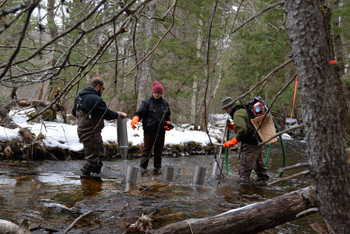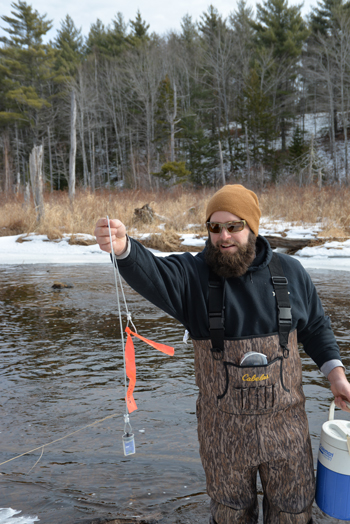Improving Salmon Seeding Strategy on Downeast Rivers
From spawning to seeding, Atlantic salmon restoration thrives on cooperation, technology
by Sarah Craighead Dedmon

DMR Scientist Ernie Atkinson operates a water drill inside a metal cone fabricated for use in salmon egg planting. Once the cone is inserted through the gravel and into the river bed, salmon eggs are measured into it, and they filter to the bottom. “We pull the cone up, and the gravel collapses around it and it turns into a little redd,” said Atkinson, using the word for a riverbottom “nest” created by female salmon. Photo by Sarah Craighead Dedmon.
It’s a cold February morning, and three scientists are in a pickup truck, bouncing their way over miles of frozen blueberry barrens. They stop next to a shuttered cabin and prepare for work, donning insulated waders and lifting backpacks. Once they’ve loaded their sled with gear they set off, carrying 30,000 eggs toward the Pleasant River.
The eggs began life at the Craig Brook National Fish Hatchery in Orland, and with luck they’ll end life as adult Atlantic salmon, returning from the sea to deposit eggs of their own in the same reach. This group is working to learn what habitat conditions will make that outcome not lucky, but likely.
“We’ve all been playing around with this idea of red habitat and green habitat, red being bad, green being good,” said Ernie Atkinson, a Marine Resources Scientist with the Maine Department of Marine Resources (DMR). “We came up with this project to let the fish tell us which is which.”
There was a time when salmon teemed through coastal rivers from Long Island to eastern Canada. In 2000, the United States listed the Atlantic salmon as an endangered species, their precipitous decline due to many factors including habitat degradation, overfishing, obstructed river access, and warming waters. Today the last wild U.S. populations exist in Maine, straggling through just eight rivers including the Narraguagus, the Machias, and the Pleasant, where Atkinson’s research is focused.
“They’re some of the best rearing habitat in Downeast Maine,” said Atkinson.
Today there are federal, state, nonprofit and commercial entities working toward salmon restoration from every angle. Salmon at almost every stage — smolts, parr, fry and eggs — are regularly released into wild habitat. Atkinson’s two-year research project, designed for his University of Maine graduate degree in wildlife and fisheries ecology, starts with egg planting in the winter, and returns to map salmon counts in the fall. The project is funded by a grant from NOAA Fisheries.

This remote river reach is near-perfect salmon habitat, said Atkinson. Shade from trees, clean gravel, and carved out riverbanks all offer the fish cool places to linger and eat, so they can store up lipids for their eventual journey to the sea. Here, DSF Hatchery Manager Zach Sheller, field technician Anne Zegers and DMR Scientist Ernie Atkinson work to deposit salmon eggs through purpose-built metal cones. Photo by Sarah Craighead Dedmon.
Why is it, he asks, that habitats which appear similar to scientists are treated differently by salmon? Once analyzed, his data could go into a tool, enabling scientists to make quick egg placement decisions in unmapped river reaches.
“Ultimately, what habitat variables matter the most?” asks Atkinson, who can rattle off 10 or more possibilities, like gravel condition, and water temperature. “If you knew you only had to focus on two or three, then you could go out into unknown areas and do a rapid assessment”
There isn’t much snow on the ground, and Atkinson, field tech Anne Zegers and Downeast Salmon Federation (DSF) Hatchery Manager Zach Sheller are all pleased they can just walk to the river this time — some years require snowmobiles. This is Sheller’s seventh year going egg planting with the DMR, a role he can fill because of DSF’s unique permit allowing them to handle the endangered species. In fact, they’re the only NGO in the country who can.
“We just come out to lend a helping hand,” said Sheller. “Whether it be electric fishing, smolt trapping or redd counting.”
In his work at DSF, Sheller also uses eggs from the Craig Brook Hatchery, but those are genetically specific to the East Machias River, where DSF releases them as parr. The eggs he’s carrying today are genetically specific to the Pleasant River, and Craig Brook Fish Biologist Denise Buckley said every river has its own genetically-distinct salmon population.

With luck, some of the 90,000 eggs in these coolers will grow into Atlantic salmon, spending two years in the Pleasant River before migrating to sea for two years, then returning home to spawn. Unlike their pacific cousins, the Atlantic salmon can, theoretically, spawn more than once. Photo by Sarah Craighead Dedmon.
“They are not so genetically distinct that you could consider them different subspecies, but we treat them that way, out of an abundance of caution,” said Buckley. If the Atlantic salmon is to make a full recovery, protecting the species’ genetic diversity is paramount.
When it’s time to spawn salmon in the hatchery, Buckley jokes that the tank resembles a junior high dance — males on one side, females on the other. Every fish has been fitted with a “pit tag” that carries their data, and now that tag is scanned into a custom-made software package called “Mate Matcher.”
“When I talk to high school or college kids, I call it ‘Salmon Tinder,’” Buckley laughs, referencing the smartphone dating app. “The software calculates the genetic distance between those fish, then figures out which male and female are the best match for each other.”
Not surprisingly, a lot of the tools used in salmon restoration are purpose-built, like the tall sheet metal cones that funnel eggs into the riverbed, and the handmade wooden backpack Atkinson wears to carry a water pump he ordered from Amazon. That pump pulls up water and then forces it back out at high speeds, creating a water “drill” that helps the team work a metal cone into the riverbed. This hydraulic method of egg planting was originally developed in Utah, and Atkinson said it does a fair job mimicking the work of a female salmon, who creates her redd by clearing gravel with her tail, laying her eggs, then moving gravel back on top of them.

Downeast Salmon Federation Hatchery Manager Zach Sheller holds a cooler of Atlantic salmon eggs in one hand and raises a thermometer in the other. DMR scientist Ernie Atkinson designed the thermometer to collect gravel temperature data once it’s planted near the eggs in the river. Though usable, this one floated too easily, so next year Atkinson will tweak his design. Photo by Sarah Craighead Dedmon.
“When the female does that, it also conditions the gravel, because it removes the fines,” said Atkinson, referring to the gravel chips and dust cleared by the salmon’s tail. “We’re doing sort of the same thing.”
When Atkinson has chosen a spot in the gravel, Zegers fits a fabricated metal cone around the drill, and Atkinson fires up its motor, gradually working the cone into the river bed.
“We’ll pepper the shoal with these cones, then we have a high-tech device for measuring eggs precisely,” said Atkinson, wryly holding up a plastic container the size of a yogurt tub. Someone has cut out one side to make a scoop they’ll use to lift the eggs from the cooler, and lay them into the cones.
“Then we pull the cone up, and the gravel collapses around it and it turns into a little redd,” said Atkinson.
The team repeats this process six times in one section of the Pleasant, then they’ll plant another 30,000 eggs in another section, carefully chosen to be two kilometers from the first. This site is difficult to access, at the bottom of a steep ravine, and requires a rope to lower and raise the gear. At least one person involuntarily slides to their destination.
In total, Atkinson is collecting data from three sections of the Pleasant, Machias and Narraguagus Rivers. The eggs planted this February will likely emerge from the gravel in late April or early May.
“This is how we’re getting fish in the water, but the real work happens in September when we go back and we electrofish,” said Atkinson. Using a pulse of DC electricity, the team will temporarily stun the fish. Then they’ll count how many they find, and what kind of habitat they found them in.
“If we have more or less the same abundance of fish throughout that two-kilometer block, that tells me the fish have distributed evenly, and all the habitat is good,” said Atkinson.
But what might that dispersal mean for the future of salmon egg planting? Like any good scientist, Atkinson’s mind is open.
“I don’t know,” he said. “We’re still working on that part.”

